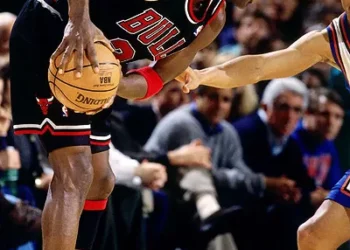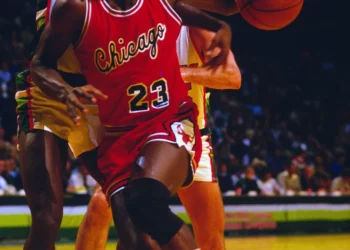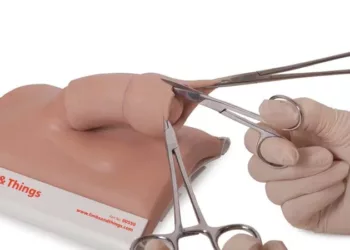The whistle blows. The referees prepare to toss the ball up. The two centers stand poised, ready to explode into the air the moment the official releases it from his hands.
This opening tip-off is one of the most iconic scenes in basketball. When executed properly, it can provide critical momentum right from the start.
What Exactly Is a Tip-Off in Basketball and What Are Its Fundamental Rules?
Simply put, the tip-off is how games start in basketball. After the starting lineups are announced, the referee brings one player from each team to center court for a “jump ball” to determine first possession:
“The game shall start with a jump ball in the center restraining circle between any two opponents. The jumpers shall stand with their feet on that half of the restraining circle nearest their own basket with one foot close to the center line” (NBA Rule 4, Section I).
The two players stand facing each other, toes touching the center circle line. When the referee tosses the ball directly upward, they attempt to “tap” or “tip” it to a teammate. Whoever ends up gaining control earns the first offensive possession for their team.
Players cannot tap the ball before it reaches its peak and starts descending. Jumping too early constitutes a violation, resulting in a turnover. The referee re-administers the tip-off in cases with violations.
Beyond starting games, tip-offs are also used to restart play after any double fouls or double lane violations (NBA Rule 7, Section V).
How Does the Tip-Off Set the Tone for a Basketball Game?
While largely symbolic, successfully winning the opening tip can still provide both practical and psychological edges.
Momentum and Confidence. Getting that first possession allows a team to immediately implement their offensive game plan. Score on that initial play and you instantly deflate your opponent while energizing your own guys. Studies show scoring first boosts win probability by 5-7% across sports, a significant margin in closely contested games.
Establishing Stars. Coaches often put their best “leapers” at center for the tip. If your top players can rise up for those highlight dunks or blocks right off the bat, it gets them engaged while showcasing their dominance. Fans love seeing their stars explode out of the gates.
Dictating Pace. By pushing tempo off missed shots, securing early rebounds lets you control flow. Winning the tip, even without scoring, still grants the chance to run. Tempo and tiring out opponents can influence substitutions and effectiveness as games wear on.
So in many ways, those first seconds represent a microcosm of all the game’s key factors: athleticism, scheme, psychology, stars, and pace.
What Are the Essential Rules of Basketball Every Beginner Should Know?
While basketball seems straightforward, there are intricacies beyond just putting a ball through a hoop. Here are the key basics to know (full beginner’s guide):
Scoring
- Field goals inside the three-point arc are 2 points
- Field goals beyond the three-point arc are 3 points
- Free throws are 1 point
Timing
- NBA games are four 12-minute quarters
- The shot clock is 24 seconds to attempt a shot
- 8 seconds to advance past midcourt in the frontcourt
Infractions
- Personal fouls result in free throws or side out possession
- Technical fouls result in one free throw plus possession
- Flagrant fouls result in two free throws plus possession
Violations
- Traveling, double dribble, backcourt violation, three seconds in key, goaltending
Understanding these basics allows you to better see how the tip-off translates directly into offensive execution. Teams strategize on plays meant to capitalize on getting the first possession.
What Strategies Do Teams Employ During the Tip-Off and How Important Is It in Determining Game Flow?
There’s substantial nuance behind that opening jump despite its split-second nature:
Player Personnel
- Starting center height, standing reach, vertical leap, coordination
- Chemistry between jumper and teammates based on practice
Launch Angle
- Tip backwards to create space for unhindered rebounds
- Tip sideways for outlets to guards already heading up court
Crash Priorities
- Aggressively attack offensive boards or cherry-pick in transition
- Balance providing outlet options or secondary rebound support
Positional Tactics
- Body up opponent to inhibit their jump
- Guess shot trajectory to get best rebound position
As seen above, the tip-off requires extensive coordination around planning, personnel, positioning, and execution. A perfectly played tip can mean easy fast break points, while a botched one portends future rebounding struggles.
Are There Any Notable Differences in How the Tip-Off Is Approached Across Various Levels of Play?
Absolutely. Approaches differ substantially depending on context:
NBA
- Specialized jumping centers like DeAndre Ayton or Rudy Gobert
- Sophisticated box-out schemes to enable outlets
- Elite open court speed enables greater cherry-picking reward
College
- Wider variation in roster size and height
- Strategies more tailored around specific personnel
- Increased unpredictability between teams
International
- No defensive three-seconds facilitates different big man spacing
- Differences in court dimensions change geometry of boxouts
- Increased physicality with fewer fouls called
So while the tip might always start games the same way, teams certainly gameplan for it distinctly based on level. NBA clubs in particular invest substantial resources into perfecting this subtle art.
The table below summarizes key strategic differences across levels:
| Level | Personnel | Execution | Context |
|---|---|---|---|
| NBA | Specialized centers | Sophisticated schemes | Elite speed |
| College | Personnel variability | Tailored approaches | Less continuity |
| International | Big man spacing | Court dimensions | Physical play |
In closing, never underestimate the tip-off. Sure, over 48 minutes those first 2 points might not seem significant in a 110-102 final score. But securing that initial edge sets a crucial tone, rewarding sound stratagem with early momentum. This forgotten finesse rightly deserves appreciation as a subtle pivotal art.
















































